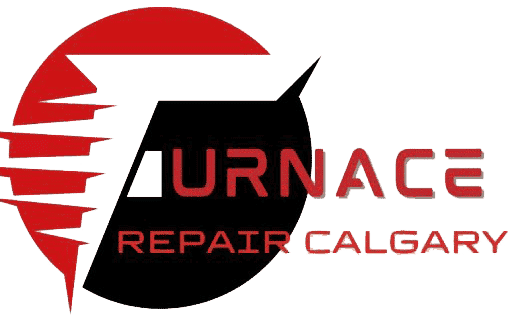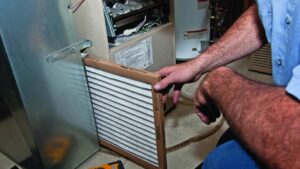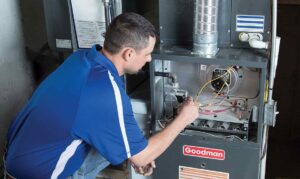Furnace Making Loud Whistling Noise
A furnace is an essential component of your home heating system. It keeps you warm during winter by circulating warm air throughout your living spaces. However, a furnace can sometimes make strange noises, which can be bothersome and indicate a problem. One such noise is a loud whistling sound. This article will explore why your furnace making loud whistling noise and what you can do about it.
Clogged Air Filter
An air filter is essential to your furnace for keeping the air your family breathes clean and healthy. It traps dust, pollen, and other particles that can cause allergies, asthma, or other respiratory issues. Air filters come in various types, including pleated, fibreglass, and electrostatic. Fibreglass filters are the most economical option but offer limited filtration, whereas pleated and electrostatic filters offer higher efficiency.
A clogged air filter prevents adequate airflow to the furnace, which disrupts the combustion cycle and causes a whistling sound. When the furnace draws in air through the filter, the amount of air it receives is reduced, causing it to work harder to do its job, leading to high-pressure differentials. These differentials can cause air to enter the furnace, creating a whistling sound as it passes through the gaps in the ductwork. If left untreated, this could lead to further problems, including inadequate heating and lower energy efficiency.
Blocked Air Vents
Air vents, or air registers or grilles, are openings in your home’s walls, floors, or ceilings that allow air to flow in and out of your living spaces. They help your furnace distribute warm air evenly throughout your home, ensuring no cold spots or areas are hotter than others. Different types of vents suit different home heating systems, including the forced-air, gravity, and hydronic systems.
Blocked air vents can cause a whistling noise in a furnace by restricting airflow. If the furnace cannot get enough air, it can overheat, which causes the ductwork to expand, leading to a whistling sound as hot air escapes through small gaps or cracks. Additionally, the whistling sound may occur when vents are partially or fully closed due to debris or obstructions. It restricts airflow, creating a pressure differential that leads to a whistling sound as the air rushes out of the gaps.
Here are some steps you can take to fix blockages causing the whistling sound in your furnace:
- Check all vents and registers
- Remove any debris, such as dust, hair or pet fur, from the vents and registers
- Vacuum the vents and registers to remove any remaining debris
- Close any partially open vents to help adjust the airflow
- Check the vent covers to ensure they are properly installed and not loose
Obstructed Heat Exchanger
A heat exchanger is a device that facilitates the transfer of heat from one fluid or gas to another, usually allowing hot air or water generated by your furnace to transfer its heat to pass an air that flows through your ductwork. The heat transfer process can occur through various materials, like metals, ceramics and polymers, and can use different heat sources, depending on the energy source used by your furnace.
An obstructed heat exchanger can cause a whistling noise in a furnace because it limits the ability of the system to transfer heat effectively. It forces the furnace to work harder, leading to higher pressure over the obstructed part, which creates whistling as air tries to escape through the gaps. An obstructed heat exchanger can also cause the furnace to generate higher heat levels than necessary, overheating the system and causing various issues.
Malfunctioning Blower Motor
A blower motor is an electric motor that blows warm air through your home’s ductwork. It rotates a fan that draws air over the heat exchanger and circulates air throughout your home. Different types of blower motors come at a fixed speed, multi-speed or variable speed, depending on their specific design and purpose of use.
A malfunctioning blower motor can cause a whistling noise in a furnace when it cannot push enough air through the ductwork. It can happen when there is a mechanical failure, such as a broken fan blade or a worn-out bearing, which can cause the motor to work more slowly than normal. The motor’s electrical wiring may also cause delivery problems, leading to low voltage and impacting the motor’s ability to function correctly. Both scenarios can cause a build-up of pressure in the ductwork, leading to cracks and gaps which emit a whistling sound.
Fixing a malfunctioning blower motor can require expertise and should be left to professionals. However, here are some basic steps you can take:
- Turn off the furnace
- Access the blower motor
- Inspect the motor for visible signs of damage or wear
- Check the motor’s electrical connections
- Repair or replace the motor or components as needed
- Test the furnace to ensure the repair worked.
Conclusion
A whistling furnace can be a significant annoyance and a sign of a problem with your heating system. Four common causes of a whistling furnace include a clogged air filter, blocked air vents, an obstructed heat exchanger, and a malfunctioning blower motor.
These issues can be fixed by changing the air filter, unblocking the air vents, cleaning the heat exchanger, and repairing or replacing the blower motor. If you are uncomfortable performing these tasks yourself, it’s best to call an HVAC professional to handle it.
Avoid costly repairs and keep your heating system running smoothly and efficiently by performing regular maintenance on your furnace to ensure it functions optimally. It includes checking the filter regularly, inspecting and cleaning the ducts, inspecting the heat exchanger for any obstruction or damage, and ensuring that all electrical connections in the furnace are securely connected and in good condition. Trusting a licensed HVAC professional with maintenance activities can help ensure your heating system works effectively and safely throughout the cold winter.






